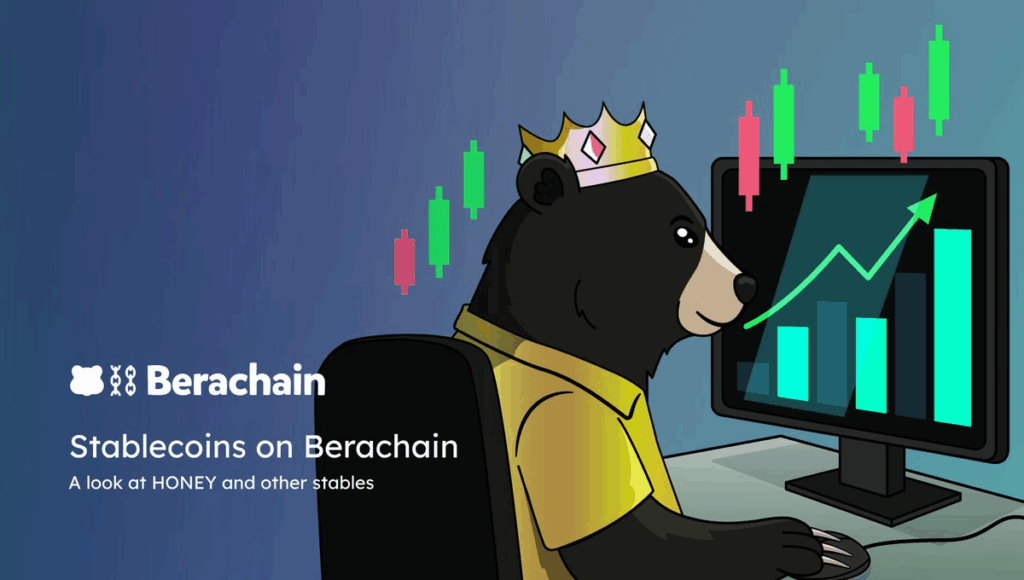- Berachain introduces Proof-of-Liquidity, where validators stake LP tokens instead of idle coins, keeping assets productive.
- Its tri-token model separates gas, governance, and stablecoin roles across BERA, BGT, and HONEY.
- Backed by $140M+ in funding and rapid developer adoption, Berachain aims to redefine DeFi with capital efficiency at its core.
Berachain is emerging as one of the most ambitious projects in the blockchain space. The network introduces a paradigm shift in consensus mechanisms by replacing traditional Proof of Stake with Proof of Liquidity. This innovation is not just a technical upgrade but a fundamental rethinking of how blockchains align incentives for validators, developers, and users. By keeping staked assets active in DeFi rather than locked away, Berachain promises a more productive and dynamic ecosystem. So, let us take a closer look at how Berachain works, why it matters, and what it could mean for the future of decentralized finance.

What Is Berachain?
Berachain is a high-performance Layer-1 blockchain built by the pseudonymous Bera Builders collective. It is designed to be EVM-identical, meaning it mirrors Ethereum’s execution layer down to the opcode, gas rules, and upgrade pathways. This allows developers to migrate Solidity contracts without rewriting a single line of code. But Berachain is not just a clone—it is a radical departure from the status quo, introducing Proof-of-Liquidity (PoL) as its consensus mechanism and separating core blockchain functions into three distinct tokens: BERA, BGT, and HONEY.
Berachain’s core mission is to blend high-performance DeFi with real-world adoption while creating a governance and incentive structure that rewards active participation rather than passive staking. This makes it more than a blockchain upgrade — it is a reinvention of how blockchain economics work.

Core Components
Berachain’s architecture is built on three foundational pillars: EVM-identical execution, Proof-of-Liquidity consensus, and tri-token economics. Each plays a critical role in shaping the network’s performance, usability, and governance.
Proof of Liquidity (PoL)
At the heart of Berachain lies Proof of Liquidity. Validators stake whitelisted liquidity pool tokens rather than idle coins. These tokens continue earning fees while securing the network, creating a feedback loop between liquidity provision and blockchain security.
Tri-Token Model
Berachain separates gas, governance, and stablecoin functions into three distinct assets:
- BERA – The gas and block reward token. BERA is used for transaction fees and staking. Recent upgrades introduced native yield for stakers, redirecting part of protocol emissions to create long-term demand and incentivize holding.
- BGT – A non-transferable governance token earned through liquidity provision. It grants voting power over protocol upgrades and validator delegations. This creates a circular economy where liquidity providers directly influence network governance, adding depth to its incentive structure.
- HONEY – An over-collateralised stablecoin pegged to USD. HONEY is minted by locking approved collateral, allowing DeFi users to access stable value while supporting liquidity in the system.
EVM Compatibility
Berachain is fully compatible with Ethereum’s virtual machine, meaning every Ethereum-based tool and protocol integrates without modification. Developers can deploy dApps using MetaMask, Hardhat, Foundry, and other familiar tools without modification. This design choice eliminates friction and accelerates adoption, while also allowing Berachain to instantly integrate Ethereum upgrades like Dencun.

What Problems Does It Solve?
Berachain tackles several issues that plague traditional blockchains. This includes:
- Liquidity Lockup – Proof-of-Stake chains require users to lock assets for staking, reducing available liquidity for DeFi. Berachain’s PoL model keeps staked assets active, allowing them to earn yield while securing the network.
- Incentive Misalignment – In PoS systems, staking competes with DeFi usage. Berachain aligns incentives by rewarding liquidity provision, ensuring that validators and users contribute to ecosystem growth rather than sidelining capital.
- Cold Start for dApps – New protocols often struggle to attract liquidity. Berachain solves this by allowing dApps to bribe validators for BGT emissions, guaranteeing immediate liquidity and bootstrapping adoption.
- Governance Centralization – Traditional governance models favor large token holders. Berachain democratizes governance by tying voting power to liquidity provision, ensuring that active participants shape the network’s future.
Utility and Offerings
Berachain offers a range of utilities designed to integrate core blockchain functions with high-performance DeFi. This includes:
BEX – Native Decentralized Exchange
BEX is Berachain’s native DEX. It allows trading of ERC-20 pairs and rebates part of gas costs to BGT holders who participate in governance. This creates a self-reinforcing loop where trading activity supports governance and vice versa.
BEND – Lending Protocol
BEND enables users to borrow HONEY or leverage staked assets. It focuses on capital efficiency, allowing users to access liquidity without removing assets from productive pools.
BERP – Perpetual Swap Platform
BERP offers leveraged trading up to 20 times on major pairs. It targets professional DeFi traders and institutions seeking high leverage opportunities.
Liquidity Rewards
Users providing liquidity to specific pools can deposit LP tokens into reward vaults to earn BGT in addition to trading fees. This incentivizes deeper liquidity and creates more opportunities for active participation.
Validator Participation
Validators earn BGT, staking rewards, and bribes from applications competing for their support. This dynamic market incentivizes efficiency and ecosystem collaboration.

Key Milestones and Highlights
Berachain’s ecosystem is growing rapidly, fueled by developer interest, institutional backing, and strategic partnerships. The chain has raised over 140 million dollars from top-tier investors including Polychain Capital, Framework Ventures, and Brevan Howard Digital. Its modular infrastructure and EVM-identical design have attracted developers from Ethereum, Arbitrum, and Polygon, while its liquidity-first consensus has drawn attention from DeFi protocols seeking capital efficiency.
The Build-A-Berathon hackathon series in August 2025 showcased dozens of new decentralized applications, integrations, and tooling upgrades, highlighting the speed at which the ecosystem is expanding. Fireblocks announced support for Berachain at mainnet launch, offering custody, staking, and dApp connectivity for institutional clients. Partnerships with staking providers like Figment and Kiln further reinforce validator infrastructure, ensuring scalability and resilience as the network matures.
Together, these developments underline Berachain’s ambition to become not only a hub for DeFi experimentation but also a platform where institutions and developers alike find long-term value.

Roadmap and Plans Ahead
Looking ahead, Berachain’s roadmap focuses on scaling, governance, and ecosystem expansion. Key priorities include:
- Ecosystem Expansion – Growing native DEX liquidity, expanding lending markets, and introducing new derivative products.
- Web2 Integration – Onboarding traditional businesses for payments and tokenized asset operations.
- Cross-Chain Expansion – Developing bridges and integrations to bring liquidity and assets across chains.
- Governance Evolution – Expanding BGT utility and refining governance mechanisms for deeper decentralization.
- Developer Support – Continuing hackathons and improving BeaconKit to make Berachain the easiest EVM-compatible chain for innovation.
Final Thoughts
In conclusion, Berachain offers a bold reimagining of blockchain incentives by tying liquidity provision directly to network security. Its Proof of Liquidity consensus, dual-token model, and focus on capital efficiency could set a new standard for how blockchains evolve. So, as the project advances through 2025 and into 2026, it will be interesting to see how it reshapes the broader crypto landscape.














